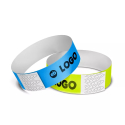Fabric wristbands have become essential for events such as festivals, concerts, and conferences.
In addition to being functional, they are an excellent medium for reinforcing your brand identity.
But how can you choose the best printing method to ensure unique and durable wristbands?
This guide explores the different printing techniques suited for fabric wristbands, while also covering the most effective methods for customising silicone, vinyl, and Tyvek wristbands.
Dive into the world of wristband customisation and learn how to transform a simple accessory into a powerful communication tool!
What Is Thermal Sublimation Printing?
Thermal sublimation printing is the most common method for fabric wristbands, especially those made from polyester. It is ideal for events where aesthetics and durability are key, as it allows for detailed and vibrant designs.
How It Works:
The design is printed on special paper and then transferred onto the wristband using a heat press. Under heat, the ink turns into gas and penetrates directly into the fabric fibres, making the design permanent.
Advantages:
- Superior Quality: Produces vibrant colours and detailed designs with high precision.
- Durability: Resistant to water, UV rays, and friction, ensuring a long lifespan.
- Unlimited Colour Range: Allows for gradients and multicoloured designs with no restrictions.
Disadvantages:
- Higher Cost: Requires specialised equipment, making it more expensive.
- Material Limitations: Only works on synthetic fabrics like polyester, preferably on light-coloured surfaces.
What Is Screen Printing?
Screen printing is a classic method for fabric wristbands, best suited for simple, single-colour designs. It is highly popular for large quantities due to its cost-effectiveness.
How It Works:
A silk screen is used to apply ink onto the wristband, layer by layer, depending on the number of colours in the design.
Advantages:
- Low Cost: Very economical for bulk orders.
- Durability: The design remains visible even after extensive use and exposure to outdoor conditions.
- Bright Colours: Produces opaque colours that stand out well against the wristband's background.
Disadvantages:
- Limited to 4 Colours: More suitable for simple designs with fewer colours.
- No Gradients: Complex images with shades and gradients cannot be reproduced accurately.
What Is Digital Transfer Printing?
Digital transfer printing is a modern method that allows for the reproduction of complex and colourful designs on fabric wristbands. It is particularly suited for small batches and intricate designs.
How It Works:
The design is printed onto a transfer medium and then applied to the wristband using a heat press. This process ensures high precision in reproducing details.
Advantages:
- No Colour Limits: Perfect for multicoloured designs, including photos or logos with complex shades.
- Fast Process: Ideal for urgent orders or small quantities.
- Cost-Effective for Small Batches: Cheaper than screen printing for smaller orders.
Disadvantages:
- Less Durable: Designs may fade or wear off over time with intensive use.
- Better on Light-Coloured Fabrics: Colours on darker surfaces may not appear as vibrant.
Printing Methods for Other Types of Wristbands
1. Silicone Wristbands
Often used for long-term events or awareness campaigns, their flexible material requires specific printing techniques:
- Screen Printing: Ideal for simple designs in one or more colours, offering good durability.
- Engraving or Debossing: A highly popular method where the design is etched into the silicone and filled with colour, ensuring maximum resistance to wear.
2. Vinyl Wristbands
Known for their durability, vinyl wristbands are perfect for extended events.
- Screen Printing: Used for simple and durable designs.
- Digital Transfer: Suitable for intricate and multicoloured designs, though less durable than screen printing.
3. Tyvek Wristbands
Perfect for single-day events, these wristbands are lightweight, water-resistant, and cost-effective.
- Screen Printing: Commonly used for simple designs with excellent value for money.
- Flexographic Printing: Mainly used for large volumes, this technique allows for rapid printing of simple designs.
Summary Table of Printing Methods by Wristband Material
|
Material |
Thermal Sublimation |
Screen Printing |
Digital Transfer |
Engraving |
Flexographic Printing |
|---|---|---|---|---|---|
|
Fabric (Polyester) |
Yes |
Yes |
Yes |
No |
No |
|
Silicone |
No |
Yes |
No |
Yes |
No |
|
Vinyl |
No |
Yes |
Yes |
No |
No |
|
Tyvek |
No |
Yes |
No |
No |
Yes |
Customising wristbands goes far beyond their basic functionality. By choosing the right printing technique for your needs – whether for fabric, silicone, vinyl, or Tyvek wristbands – you can turn a practical accessory into a powerful communication tool. Whether you opt for thermal sublimation for vibrant designs or screen printing for simple and impactful patterns, the choice of printing method can make all the difference. So, don’t hesitate to make wristbands a standout element of your event, leaving a lasting impression on your participants!
You may also like these pages:











































